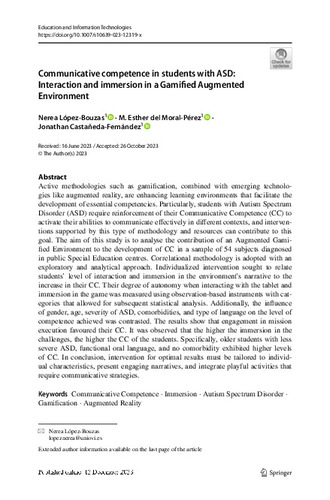Communicative competence in students with ASD: Interaction and immersion in a Gamified Augmented Environment
Subject:
Communicative Competence
Immersion
Autism Spectrum Disorder
Gamification
Augmented Reality
Publication date:
Editorial:
Springer
Publisher version:
Citación:
Abstract:
Active methodologies such as gamification, combined with emerging technologies like augmented reality, are enhancing learning environments that facilitate the development of essential competencies. Particularly, students with Autism Spectrum Disorder (ASD) require reinforcement of their Communicative Competence (CC) to activate their abilities to communicate effectively in different contexts, and interventions supported by this type of methodology and resources can contribute to this goal. The aim of this study is to analyse the contribution of an Augmented Gamified Environment to the development of CC in a sample of 54 subjects diagnosed in public Special Education centres. Correlational methodology is adopted with an exploratory and analytical approach. Individualized intervention sought to relate students' level of interaction and immersion in the environment's narrative to the increase in their CC. Their degree of autonomy when interacting with the tablet and immersion in the game was measured using observation-based instruments with categories that allowed for subsequent statistical analysis. Additionally, the influence of gender, age, severity of ASD, comorbidities, and type of language on the level of competence achieved was contrasted. The results show that engagement in mission execution favoured their CC. It was observed that the higher the immersion in the challenges, the higher the CC of the students. Specifically, older students with less severe ASD, functional oral language, and no comorbidity exhibited higher levels of CC. In conclusion, intervention for optimal results must be tailored to individual characteristics, present engaging narratives, and integrate playful activities that require communicative strategies.
Active methodologies such as gamification, combined with emerging technologies like augmented reality, are enhancing learning environments that facilitate the development of essential competencies. Particularly, students with Autism Spectrum Disorder (ASD) require reinforcement of their Communicative Competence (CC) to activate their abilities to communicate effectively in different contexts, and interventions supported by this type of methodology and resources can contribute to this goal. The aim of this study is to analyse the contribution of an Augmented Gamified Environment to the development of CC in a sample of 54 subjects diagnosed in public Special Education centres. Correlational methodology is adopted with an exploratory and analytical approach. Individualized intervention sought to relate students' level of interaction and immersion in the environment's narrative to the increase in their CC. Their degree of autonomy when interacting with the tablet and immersion in the game was measured using observation-based instruments with categories that allowed for subsequent statistical analysis. Additionally, the influence of gender, age, severity of ASD, comorbidities, and type of language on the level of competence achieved was contrasted. The results show that engagement in mission execution favoured their CC. It was observed that the higher the immersion in the challenges, the higher the CC of the students. Specifically, older students with less severe ASD, functional oral language, and no comorbidity exhibited higher levels of CC. In conclusion, intervention for optimal results must be tailored to individual characteristics, present engaging narratives, and integrate playful activities that require communicative strategies.
ISSN:
Collections
- Artículos [36307]
- Ciencias de la Educación [1020]
- Investigaciones y Documentos OpenAIRE [7936]
Files in this item





